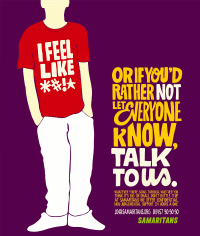We had a guest speaker at our Samaritans AGM tonight – Joe Ferns from General Office – who talked about suicide and depression in men. I’ve heard the statistic many times before that young men are more likely to die by suicide. I wasn’t aware that (although the overall number of suicides is slowly decreasing) the gap between number of suicides in men and women is widening – and has been for several decades. Joe gave an interesting perspective on some of the reasons behind this.
He talked about the stigma around men expressing emotion in public, and society’s tolerance of “emotional health” as an issue for men. For example, there is a difference in the reaction to a woman who cries at work, to a man who does this. With a woman, people are often sympathetic and understanding. With a man, people often disapprove and think that there must be “something wrong with him”.
He argued that we need to shift this perspective, and change our language when discussing emotional health – to make it more acceptable. As an example, he talked about a course he ran in a corporate workplace for men on coping with anxiety. Noone signed up. The same course rebranded as a workshop on coping with stress was oversubscribed several times over. ‘Stress’ is acceptable. As men, we’re allowed to feel stressed. It’s almost a sign that we’re working hard and doing our jobs well. ‘Being anxious’ isn’t. It’s a sign of weakness.
This is something that we need to look at in the language we use in Samaritans. We describe our service as being about “listening”, when we could talk about helping callers to “generate options” or “identify and name their feelings”. It’s the same thing, but perhaps describing it in a way which isn’t as implicitly feminine sounding would make it more acceptable to potential male callers?
I think that Samaritans as an organisation is getting better at ‘marketing’ our services. The advertising I remember from the past showing someone at the end of their rope, and calling Samaritans as a last resort has been replaced with more friendly, less dramatic suggestions for people to call when they’re feeling down or want to talk about something.
 Posters showing a frantic person clutching pills in one hand and a phone in the other used to be the approach. They needed people to be able to identify with someone this desperate to feel that calling Samaritans was for them. More recent posters like this one remove this barrier – and present an image that people can identify with more easily without having to admit to being weak or a victim.
Posters showing a frantic person clutching pills in one hand and a phone in the other used to be the approach. They needed people to be able to identify with someone this desperate to feel that calling Samaritans was for them. More recent posters like this one remove this barrier – and present an image that people can identify with more easily without having to admit to being weak or a victim.
Using humour like in the recent cinema adverts also aim to make it more approachable and acceptable.
The talk, and the discussion afterwards, was very interesting and hopefully it might make us a little better at what we do.